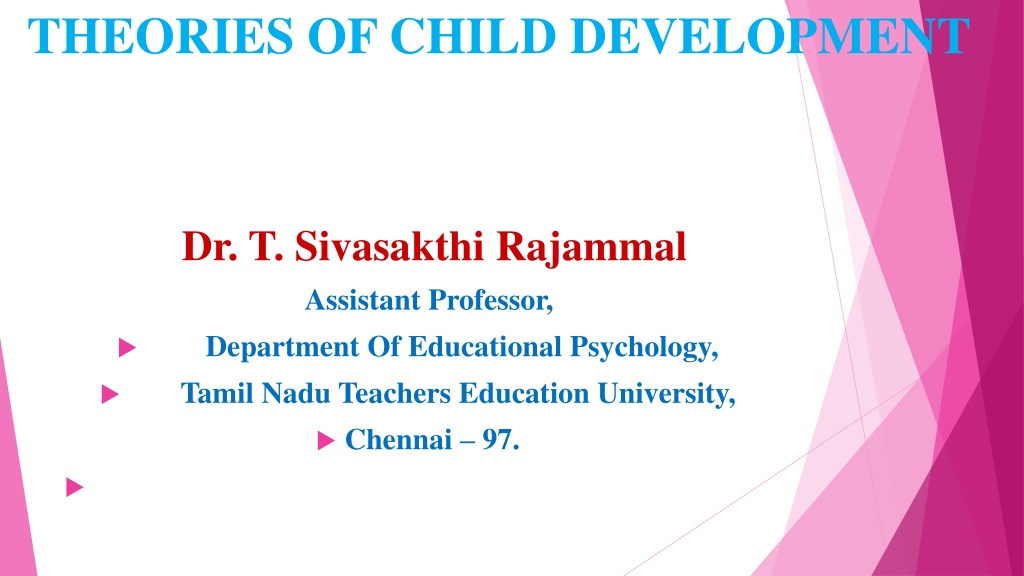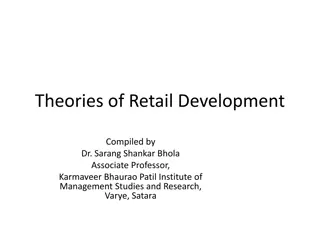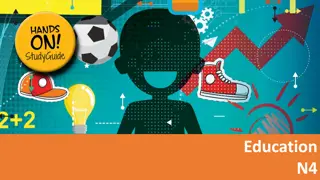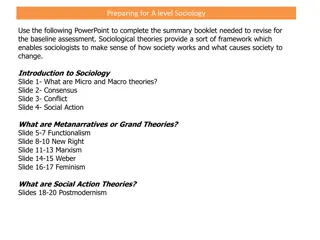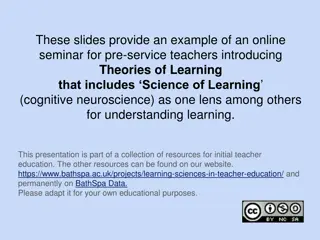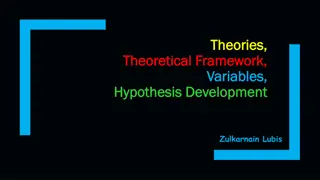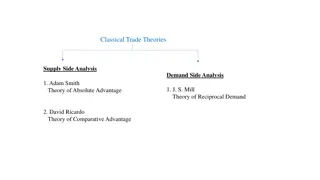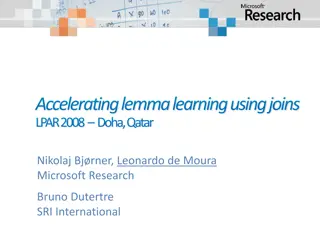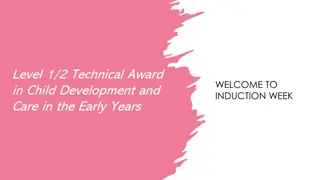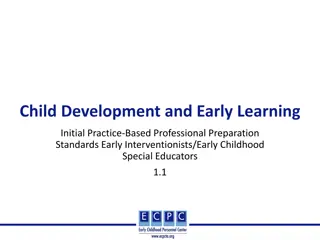Understanding Theories of Child Development by Dr. T. Sivasakthi Rajammal
Child development theories such as Erikson's psycho-social theory, Piaget's cognitive development theory, and Kohlberg's moral development theory explain how children grow and change across different stages of childhood. These theories focus on various aspects of development including social, emotional, and cognitive growth. Each stage presents unique challenges and opportunities for individuals to develop key skills and attributes that shape their sense of self and interaction with the world.
Download Presentation

Please find below an Image/Link to download the presentation.
The content on the website is provided AS IS for your information and personal use only. It may not be sold, licensed, or shared on other websites without obtaining consent from the author. Download presentation by click this link. If you encounter any issues during the download, it is possible that the publisher has removed the file from their server.
E N D
Presentation Transcript
THEORIES OF CHILD DEVELOPMENT Dr. T. Sivasakthi Rajammal Assistant Professor, Department Of Educational Psychology, Tamil Nadu Teachers Education University, Chennai 97.
Introduction Child development theories focus on explaining how children change and grow over the course of childhood. Such theories on various aspects of development including social, emotional, and cognitive growth. The study of human development is a rich and varied subject. Erikson said that our social interaction and successful completion of social tasks shape our sense of self. Jean Piaget proposed a theory of cognitive development that explains how children think and reason as they move through various stages. Finally, Lawrence Kohlberg turned his attention to moral development. He said that we pass through three levels of moral thinking that build on our cognitive development. You ll learn about each of these theories in this section.
I. ERIKSONS PSYCHO SOCIAL THEORY Introduction Erickson s theory consists of eight stages of development. Each stage is characterized by a different conflict that must be resolved by the individual. If a person is unable to resolve a conflict at a particular stage, they will confront and struggle with it later in life.
Sl. No. APPROXIMATE AGE ERIKSON S PSYCHOSOCIAL STAGE Basic trust versus mistrust: From warm, respe care, infants gain a sense of trust, or consivnofidence, that Stage 1Birth-1 year the world is good. Mistrust occurs if infants are neglected or handled harshly. Autonomy versus shame and doubt: Using new mental and motor skills, children what to decide for themselves. Parents can foster autonomy by Stage 21-3 years permitting reasonable free choice and not forcing or shaming the child
children gain insight into the person they can become Initiative a sense of ambition and responsibility Stage 33 - 6 years develops when parents support their child s sense of purpose. But if parents demand too much self-control, children experience excessive guilt. Industry versus inferiority: At school, children learn to work and cooperate with others. Inferiority develops when negative experiences at home, at Stage 46 - 11 years school, or with peers lead to feelings of incompetence.
Identity versus role confusion: By exploring values and vocational goals, the young person forms a Stage 5 Adolescence personal identity. The negative outcome is confusion about future adult roles. Intimacy versus isolation: Young adults establish intimate relationships. Because of earlier disappointments, some individuals cannot form close Stage 6 Young adulthood bonds and remain isolated.
Sl. No. APPROXIMATE AGE ERIKSON S PSYCHOSOCIAL STAGE Generativity versus stagnation: Generativity giving to the next generation through child rearing, Middle adulthood for others, or productive work. The person who fails Stage 7 these ways feels an absence of meaningful accomplishment. Integrity versus despair: Integrity results from that life was worth living as it happened. Older Stage 8 Old age who are dissatisfied with their lives fear death.
Conclusion Everyone wants to achieve his/her basic needs in their life. Therefore Erickson concluded that human development progresses according to specific stages. He also states that each of those stages has crisis and those crisis must be dissolved before an individual can function successfully.
II. PIAGETS COGNITIVE-DEVELOPMENTAL THEORY Introduction According to his cognitive-developmental theory, children actively construct knowledge as they manipulate and explore their world. In piaget s theory, as the brain develops and experiences expand, they move through four broad stages, each characterized by qualitatively distinct ways of thinking. Following figures on provides a brief description of piaget s stages.
Figure 2 Piaget s Stages of Cognitive Development j
Piagets Stages of Cognitive Development 1. Sensorimotor (Birth-2 years) Infants think by acting on the world with their eyes, ears, hands, and mouth. As a result, they invent ways of solving sensorimotor problems, such as pulling objects into and taking them out of containers.
2. Preoperational Stage(2-7 years) Preschoolchildren use symbols to represent their earlier sensorimotor discoveries. Development of language and make-believe play takes place. However, thinking lacks the logic of the two remaining stages.
3. Concrete operational Stage(2-7 years) Children s reasoning becomes logical and better organized. School age children understand that a certain amount of lemonade or play dough remains the same even after its appearance changes. They also organize objects into hierarchies of classes and subclasses. However, thinking falls short of adult intelligence. It is not yet abstract.
4. Formal operational Stage(11 years on) The capacity for abstract, systematic thinking enables adolescents, when faced with a problem, to start with a hypothesis, deduce testable inferences, and isolate and combine variables to see which inferences are confirmed. Adolescents can also evaluate the logic of verbal statements without referring to real-world circumstances.
Conclusion Conclusively the results of Piaget s work changed the way that teacher, parents and all those who work with and around children observe the children s behavior and response to their environment. Piaget s work specifically had an impact on the teaching of education in schools. It was also found by later studies that Jean Piaget s work and results of his work with children held true children from different countries, especially his results from early development. Even though some of his studies and study techniques have been criticized Jean Piaget s work started a trend within the study of children s behavior in their environment and their development.Piaget made important contributions to our understanding of normal intellectual development. Piaget theories provide a fundamental starting point for understanding childhood cognitive development.
III. KOHLBERG STAGES OF MORAL DEVELOPMENT Introduction Moral development is an important part of the socialization process. The term refers to the way people learn what society considered to be good and bad, which is important for a smoothly functioning society. Moral development prevents people from acting on unchecked urges, instead considering what is right for society and good for others. Lawrence Kohlberg (1927 1987) was interested in how people learn to decide what is right and what is wrong. Lawrence Kohlberg expanded on the earlier work of cognitive theorist Jean Piaget to explain the moral development of children. To understand this topic, he developed a theory of moral development that includes three levels: pre-conventional, conventional, and post-conventional. Kohlberg believed that moral development, like cognitive development, follows a series of stages.
Figure 3 Kohlberg's Stages of Moral Development https://figures.boundless-cdn.com/31557/large/2ix7jxubs6ae0yq3jaga.jpe
Kohlbergs Stages of Moral Development Kohlberg identified three levels of moral reasoning: pre-conventional, conventional, and post-conventional. Each level is associated with increasingly complex stages of moral development.
Level 1 - Pre-Conventional Morality At the pre-conventional level (most nine-year-olds and younger, some over nine), we don t have a personal code of morality. Instead, our moral code is shaped by the standards of adults and the consequences of following or breaking their rules. Authority is outside the individual and reasoning is based on the physical consequences of actions.
Stage 1. Obedience and Punishment Orientation. The child/individual is good in order to avoid being punished. If a person is punished, they must have done work. Stage 2. Individualism and Exchange. At this stage children recognize that there is not just one right view that is handed down by the authorities. Different individuals have different viewpoints.
Level 2 - Conventional Morality At the conventional level (most adolescents and adults), we begin to internalize the moral standards of valued adult role models. Authority is internalized but not questioned and reasoning is based on the norms of the group to which the person belongs.
Stage 3. Good Interpersonal Relationships: The child/individual is good in order to be seen as being a good person by others. Therefore, answers relate to the approval of others. Stage 4. Maintaining the social Order: The child/individual becomes aware of the wider rules of society so judgement concern obeying the rules in order to uphold the law and to avoid guilt.
Level 3 - Post-Conventional Morality Individual judgment is based on self-chosen principles, and moral reasoning is based on individual rights and justice. According to Kohlberg this level of moral reasoning is as far as most people get. Only 10-15% are capable of the kind of abstract thinking necessary for stage 5 or 6 (post-conventional morality). That is to say most people take their moral views from those around them and only a minority think through ethical principles for themselves.
Stage 5. Social contract and individual rights. The child/individual becomes aware that while rules/laws might exist for the good of the greatest number, there are times when they will work against the interest of particular individuals. The issues are not always clear cut. For example, Heinz s dilemma the protection of life is important than breaking the law against stealing. Stage 6. Universal Principles. People at this stage have developed their own set of moral guidelines which may or may not fit the law. The principles apply to everyone. E.g. human rights, justice and equality. The person will be prepared to act to define these principles even if it means going against the rest of society in the process and having to pay the consequences of disapproval and or imprisonment. Kohlberg doubted few people reached this stage.
Conclusion Lawrence Kohlberg s theory gives structure to an otherwise difficult to understand phenomenon. His development of morality influenced the theory of moral development in women proposed by Carl Gilligan and continues to circulate in academic circles worldwide. His work finds value not only in the world of psychology but in the world of education as well. Comprehension of his stages of moral development is important when attempting to understand the behavior and decisions made by students. Accurate assignment to a stage of development can help teachers understand why students do the things they do and how to best approach them. For example, it is useless to attempt to convince that she should sit quietly in her seat when the teacher is gone if she is in stage one of her moral development. The teacher must instead find a way to maintain then illusion of an authoritative figure while absent from the classroom. Ultimately, the teacher with the tools necessary to manage the classroom, thus enhancing the potential success of the lessons.
Conclusion Here s why Erikson and Piaget and Kohlberg matter: clinicians consciously, and parents intuitively, use all of these notions in understanding kids. Teens, for example, should be working on developing a sense of who they are, and they do so by thinking abstractly about the many options afforded them. And, engaging these process, they decide that the right thing to do stems from their view of how the world views them. If kids veer from these loosely-predictable stages, we have to ask ourselves why. Is the child depressed? Is there trouble at school? Is there trouble at home? This is where clinicians and parents collaborate best when a child is in need. Beyond just understanding how young children are growing and developing during these early ears, parents also need practical, everyday knowledge on how to care for their children and how to meet their needs.
